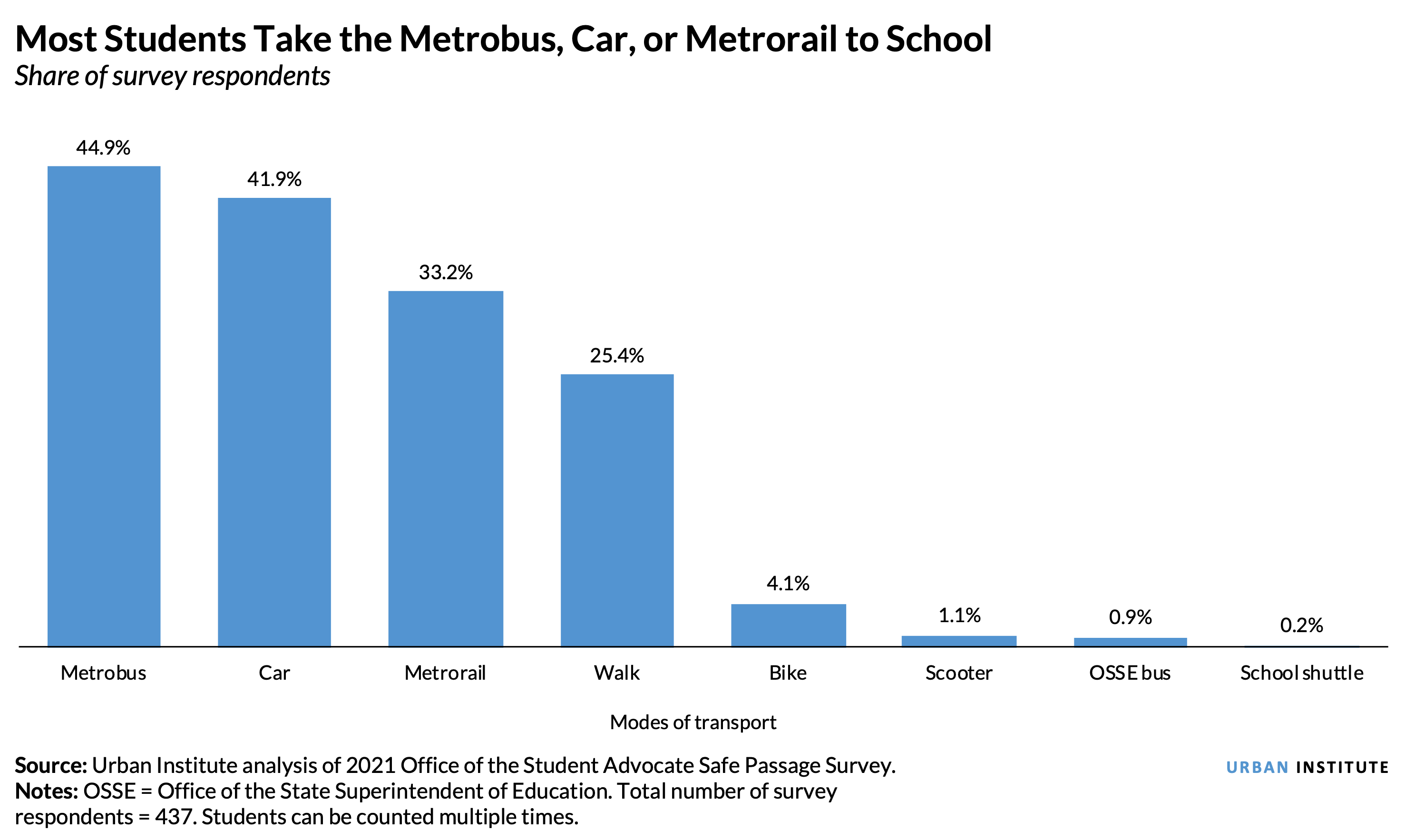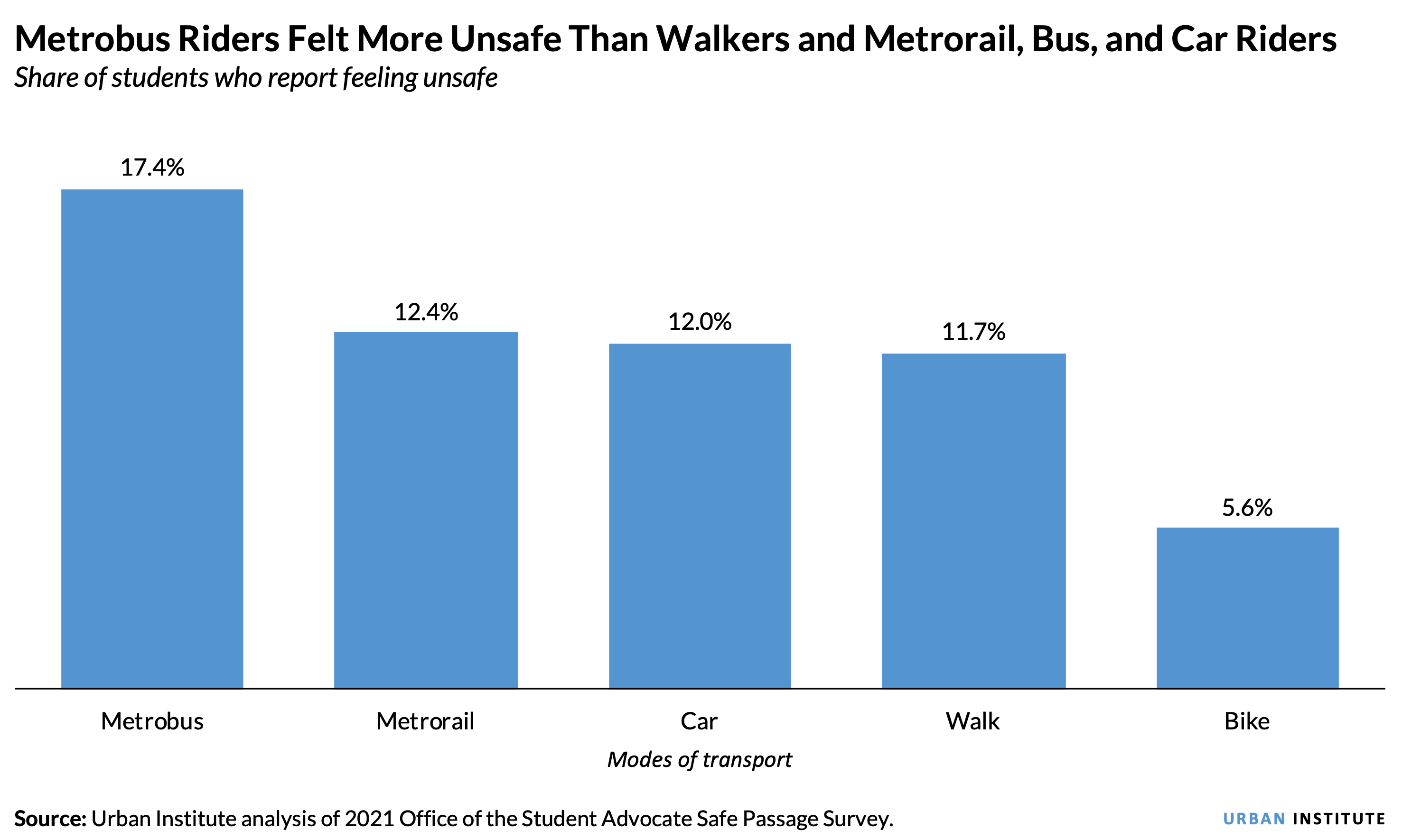
School districts across the country returned to in-person schooling in 2021, but it hasn’t been an easy transition. Pandemic-related public health concerns continue to affect students and teachers, and many threats students experienced before the pandemic have been exacerbated.
Student safety has long been a challenge, with DC previously convening the Safe Passage Working Group of government agencies, community-based organizations, and school leaders to improve travel conditions. But still, the DC area had more traffic fatalities in 2020 and again in 2021, making 2021 the “deadliest year” since 2007. Incidents involving children, some resulting in fatalities, have happened during their travels to and from school.
DC students are more exposed to traffic safety problems during their commutes than students in a majority of other districts for two reasons: students travel beyond their neighborhoods to attend DC public schools and charter schools, and DC doesn’t provide school buses unless students have special needs, meaning most students walk or travel by car or public transportation. Research shows commutes can be long for DC students, with a 31-minute average commute time for ninth-grade students on public transit.
Recently, the Urban Institute supported the Office of the Student Advocate (OSA) in the DC State Board of Education to design the 2021 OSA Safe Passage Survey about the safety threats to high school students and analyze the results. Although the overall respondent sample is not representative of all high school students, the survey demonstrates the salience of these issues among students who responded and underscores the need for policymakers and practitioners to think holistically about student safety and do more to address its different aspects.
Students feel unsafe on the way to school for many reasons
To better understand DC students’ experiences, the survey asked how students get to school and how safe they felt during their commute. To ensure students only answered questions they were comfortable answering, the survey offered students multiple opportunities to stop.
From the survey responses, we found more than 40 percent of students use multiple modes of transportation when traveling to and from school. Most commonly, students used the Metrobus to get to school, but students also reported traveling by car and Metrorail. About one-quarter of students said they walk to school.

When asked about their commute to school, one student responded, “When I say ‘walking to school,’ I mean I have to either walk to the A8 bus stop to get to school because the D12 or D14 doesn’t come a good majority of the time when we need it to get to the A8 bus stop, so we walk.”
A similar share of students (12 percent) who walk or travel by Metrorail or car to school felt unsafe, whereas students who take the Metrobus were the most likely to report feeling unsafe. One student wrote, “I also take the X2 bus route from Gallery [Place], which is very dangerous because a lot of people on that bus have mental issues.”

More than one-quarter of students reported experiencing unwanted attention or interactions during commutes, with students who identify as women reporting even higher shares. In fact, students who identify as women were twice as likely as students who identify as men to say they have experienced unwanted attention. There were not enough nonbinary respondents in our sample to present findings for that group.
One student described feeling discouraged about the harassment: “I know I’m not the only girl who has been harassed or followed by old creepy men while taking public transportation, and it’s really annoying. I wish it would stop, but I feel like there’s nothing you can really do about it.”

Although DC’s Safe Passage efforts have traditionally focused on keeping students safe from community violence or vehicular threats, the COVID-19 pandemic introduced new threats to students’ safety. Half of respondents in our sample reported some concern about getting COVID-19 while traveling to or from school, and 26 percent were extremely concerned or moderately concerned.
When students were asked about how they protect themselves from COVID-19 while commuting, 60 percent reported they would wear a mask, 30 percent said they would practice social distancing, and 22 percent said that they would avoid crowded trains. About one-quarter reported already being vaccinated at the time of the survey in July/August 2021.
But for many, COVID-19 concerns were not top of mind. One student wrote, “I’m more concerned about shootings and violence than COVID, there is a liquor store outside of the bus top, and men are always hanging around.”
Safety is multifaceted, so policy solutions should be too
The 2021 OSA Safe Passage Survey suggests students may encounter different safety threats as they travel to and from school. Students use multiple modes of transportation to get to school, so policymakers should be cognizant of addressing not only increasing vehicular fatalities but also the safety concerns of public transit riders. Further, harassment is too common, and the COVID-19 pandemic has added another layer of concern.
Recent legislation like the 2021 Safe Routes to School Expansion Regulation Amendment and Walk Without Worry Amendment Acts include important pedestrian safety provisions, but more can be done to improve safety for Metrorail and bus riders. We also need to understand whether and how recent investments in community violence reduction have changed conditions for students traveling to and from school. DC has enacted efforts to improve COVID-19-related safety in school, but these efforts don’t extend to address students’ concerns during their commutes.
Students face a variety of threats on their way to school, so a variety of policy solutions is needed.
Let’s build a future where everyone, everywhere has the opportunity and power to thrive
Urban is more determined than ever to partner with changemakers to unlock opportunities that give people across the country a fair shot at reaching their fullest potential. Invest in Urban to power this type of work.